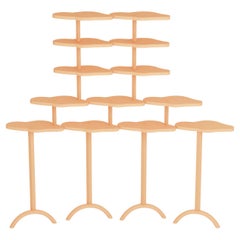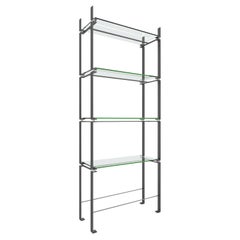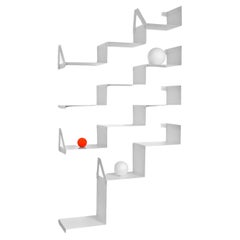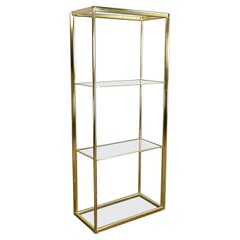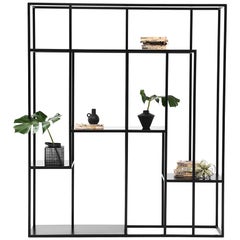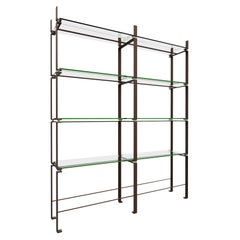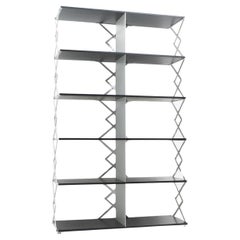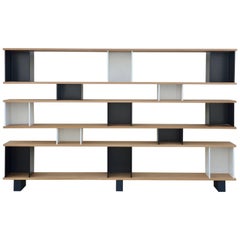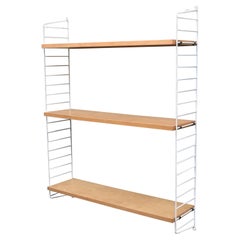Modern Design Shelves
2010s Saudi Arabian Modern Shelves
Steel
2010s American Post-Modern Shelves
Stainless Steel
2010s Danish Post-Modern Shelves and Wall Cabinets
Metal
Mid-20th Century Unknown Mid-Century Modern Shelves
Aluminum, Brass
2010s Polish Post-Modern Shelves
Steel
2010s American Post-Modern Shelves
Stainless Steel
Early 2000s Swiss Mid-Century Modern Shelves
Aluminum
21st Century and Contemporary French Modern Shelves
Steel
Vintage 1960s European Modern Shelves
Birch
Mid-20th Century European Modern Shelves
Birch
Vintage 1970s American Mid-Century Modern Shelves
Steel
20th Century Italian Mid-Century Modern Shelves
Vintage 1980s American Mid-Century Modern Shelves
Steel
20th Century American Mid-Century Modern Shelves
Chrome
2010s American Post-Modern Shelves
Metal
Vintage 1970s French Mid-Century Modern Shelves
Plastic
2010s Spanish Mid-Century Modern Shelves
Wood
2010s Spanish Mid-Century Modern Shelves
Wood
2010s Spanish Mid-Century Modern Shelves
Wood
2010s Spanish Mid-Century Modern Shelves
Wood
2010s Spanish Mid-Century Modern Shelves
Wood
Vintage 1980s Italian Modern Shelves and Wall Cabinets
Metal
21st Century and Contemporary French Modern Shelves
Steel
Vintage 1970s German Mid-Century Modern Shelves and Wall Cabinets
Plastic
Vintage 1980s German Post-Modern Shelves
Ash, Lacquer
Mid-20th Century Mid-Century Modern Shelves
Chrome
20th Century American Mid-Century Modern Shelves
Chrome
2010s Italian Minimalist Shelves and Wall Cabinets
Metal
Vintage 1970s American Mid-Century Modern Shelves
Chrome
Vintage 1960s American Mid-Century Modern Shelves
Chrome
21st Century and Contemporary Chinese Scandinavian Modern Shelves
Travertine, Marble, Metal
Vintage 1950s Italian Mid-Century Modern Shelves
Brass
2010s Turkish Modern Shelves and Wall Cabinets
Wood, Oak
2010s Turkish Modern Shelves and Wall Cabinets
Wood, Oak
2010s Turkish Modern Shelves and Wall Cabinets
Metal
2010s Turkish Modern Shelves and Wall Cabinets
Metal
2010s Turkish Modern Shelves and Wall Cabinets
Wood, Oak
2010s Turkish Modern Shelves and Wall Cabinets
Wood, Oak
2010s Turkish Modern Shelves and Wall Cabinets
Metal
2010s Turkish Modern Shelves and Wall Cabinets
Metal
2010s Turkish Modern Shelves and Wall Cabinets
Mirror, Wood, Oak
Late 20th Century French Mid-Century Modern Shelves and Wall Cabinets
Porcelain
Vintage 1930s Finnish Scandinavian Modern Shelves and Wall Cabinets
Birch
2010s Danish Post-Modern Shelves and Wall Cabinets
Metal
2010s Polish Post-Modern Shelves and Wall Cabinets
Steel
2010s Danish Post-Modern Shelves and Wall Cabinets
Metal
2010s Polish Post-Modern Shelves and Wall Cabinets
Steel
2010s Polish Post-Modern Shelves and Wall Cabinets
Steel
2010s Swedish Post-Modern Shelves and Wall Cabinets
Oak
2010s Polish Post-Modern Shelves and Wall Cabinets
Marble, Steel
2010s Swedish Post-Modern Shelves and Wall Cabinets
Oak
2010s Swedish Post-Modern Shelves and Wall Cabinets
Oak
Vintage 1940s Finnish Scandinavian Modern Shelves and Wall Cabinets
Birch
21st Century and Contemporary French Mid-Century Modern Shelves and Wall...
Elm
2010s Swedish Post-Modern Shelves and Wall Cabinets
Steel
2010s Danish Scandinavian Modern Shelves and Wall Cabinets
Aluminum
Vintage 1950s Mexican Mid-Century Modern Shelves and Wall Cabinets
Wood
- 1
- ...
Modern Design Shelves For Sale on 1stDibs
How Much are Modern Design Shelves?
Finding the Right Storage-case-pieces for You
Of all the vintage storage cabinets and antique case pieces that have become popular in modern interiors over the years, dressers, credenzas and cabinets have long been home staples, perfect for routine storage or protection of personal items.
In the mid-19th century, cabinetmakers would mimic styles originating in the Louis XIV, Louis XV and Louis XVI eras for their dressers, bookshelves and other structures, and, later, simpler, streamlined wood designs allowed these “case pieces” or “case goods” — any furnishing that is unupholstered and has some semblance of a storage component — to blend into the background of any interior.
Mid-century modern furniture enthusiasts will cite the tall modular wall units crafted in teak and other sought-after woods of the era by the likes of George Nelson, Poul Cadovius and Finn Juhl. For these highly customizable furnishings, designers of the day delivered an alternative to big, heavy bookcases by considering the use of space — and, in particular, walls — in new and innovative ways. Mid-century modern credenzas, which, long and low, evolved from tables that were built as early as the 14th century in Italy, typically have no legs or very short legs and have grown in popularity as an alluring storage option over time.
Although the name immediately invokes images of clothing, dressers were initially created in Europe for a much different purpose. This furnishing was initially a flat-surfaced, low-profile side table equipped with a few drawers — a common fixture used to dress and prepare meats in English kitchens throughout the Tudor period. The drawers served as perfect utensil storage. It wasn’t until the design made its way to North America that it became enlarged and equipped with enough space to hold clothing and cosmetics. The very history of case pieces is a testament to their versatility and well-earned place in any room.
In the spirit of positioning your case goods center stage, decluttering can now be design-minded.
A contemporary case piece with open shelving and painted wood details can prove functional as a storage unit as easily as it can a room divider. Alternatively, apothecary cabinets are charming case goods similar in size to early dressers or commodes but with uniquely sized shelving and (often numerous) drawers.
Whether you’re seeking a playful sideboard that features colored glass and metal details, an antique Italian hand-carved storage cabinet or a glass-door vitrine to store and show off your collectibles, there are options for you on 1stDibs.
- What is modern furniture design?1 Answer1stDibs ExpertAugust 8, 2024Modern furniture design is an overarching term for the new approach that designers began taking in the early 20th century. Many experts cite the Bauhaus movement as the start of the modern era. Its style was defined by the instructors and students at a progressive German art and design school founded by the architect Walter Gropius that operated from 1919 to 1933. In Bauhaus-style furniture, the school’s followers married industrial and natural materials in simple, geometric forms. The goal of the Bauhaus was to erase the distinction between art and craft while embracing the use of new technologies and materials. As the Bauhaus movement was emerging, so too was Art Deco. This iconic movement made an indelible mark on all fields of design throughout the 1920s and ’30s, celebrating society’s growing industrialization with refined elegance and stunning craftsmanship. Art Deco furniture makers respected the dark woods and modern metals with which they worked; they frequently incorporated decorative embellishments such as exotic animal hides as well as veneers in their seating, case pieces, living room sets and bedroom furniture. After World War II, modern design continued with the mid-century modern movement. The style is characterized by pieces that were conceived and made in an energetic, optimistic spirit by creators who believed that good design was an essential part of good living. Historians typically say that the modern approach to furniture design ended in the mid-1960s or early 1970s. Pieces made after that time may be called postmodern or contemporary. Shop a large collection of modern furniture on 1stDibs.
- 1stDibs ExpertSeptember 25, 2019
Some of the most famous mid-century modern furniture designers were Alvar Aalto, Charles and Ray Eames, Paul Evans, Poul Kjærholm, Florence Knoll, George Nakashima, Giò Ponti, Hans Wegner, Charlotte Perriand, Sergio Rodrigues and Eero Saarinen.
- 1stDibs ExpertSeptember 25, 2019The defining characteristics of mid-century modern furniture design include simplicity, an emphasis on organic forms, clean lines and a mix of both natural and man-made materials. The mid-century modern style, which emerged primarily in the years following World War II, is used to describe the work of furniture designers who believed that good design was an essential part of good living. Both neutral tones and bold Pop art colors can typically be found in mid-century modern interiors, which usually include light-filled spaces. An integration of floor-to-ceiling windows and abundant access to the outdoors renders prominent a connection with nature, which owes in part to the ideas of celebrated architect Frank Lloyd Wright, an inspiration for mid-century furniture designers. Popular mid-century modern designers include Ray and Charles Eames, Florence Knoll, Harry Bertoia and others. Find vintage mid-century modern furniture on 1stDibs.
- 1stDibs ExpertMarch 22, 2022Marcel Breuer introduced the material of tubular steel to modern furniture design. He employed it in many of his chairs, tables and sofas, prizing the material because it minimized the weight of pieces without sacrificing their strength. Shop a range of Marcel Breuer furniture on 1stDibs.
Read More
The Ultimate Guide to Types of Tables for the Home
Whether you’re just moving in or ready to give your home a makeover, our guide will give you pointers on tables that are fitting for every room, nook and hallway.
What Exactly Is a Secretary Desk, and What Is It Used For?
The furniture equivalent of a Swiss Army knife, it's the multifunctional piece you didn't know you needed.
This Shelving System with Oxidized Brass Tubes Is Retro and Futuristic at Once
Italian studio DimoreMilano mustered great ingenuity when crafting these sculptural shelves, which are built without any screws.
28 Cheerful Home Bars, Where Everybody (Literally) Knows Your Name
Simple or sophisticated, equipped with console, cart or custom cabinetry, these stylish bar areas deserve a toast.
Ask an Interior Designer: Work-from-Home Edition
Leaping into a design project, whether it's refreshing the bedroom or redoing the whole house, can be overwhelming. Luckily, we know more than a few interior designers. You asked questions on Instagram, and now they're answering.
Collected and Eclectic, ‘Wunderkammern’ Are Back in a Big Way
Introduced nearly 500 years ago, curiosity cabinets are finding new fans among today's collectors and designers.
Meet the Incredible Woman Transforming Fallen Trees into Sleek Furniture
In the hands of New York Heartwoods cofounder Megan Offner, unwanted local trees become works of design art.
These New York Architects Love a Complicated Project
From Brooklyn townhouses to Maine campgrounds, Trattie Davies and Jonathan Toews relish a challenge, like transforming a former warehouse space into the new 1stdibs Gallery.
